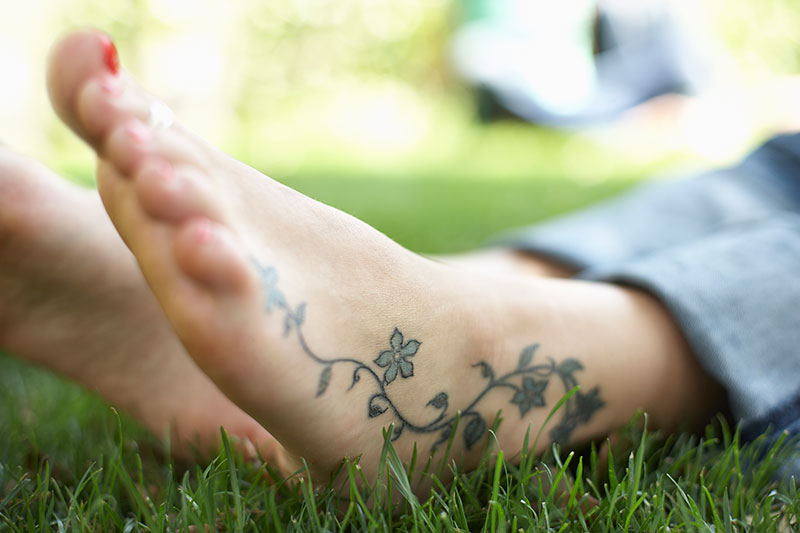Written by Shawn Radcliffe
—
[dropcap]September is here, but the sights and sounds of summer still linger in the air, like the image of people strolling on the beaches and boardwalks sporting tattoos large and small. Once a rite of passage for young adults, tattoos are now popular among people of all ages. According to a 2004 survey in the Journal of the American Academy of Dermatology, 24 percent of 18- to 50-year-olds had a tattoo. Less than one-fifth of those were “inked” by age 18. As more people get tattooed—from discrete designs on the ankle or shoulder blade, to more extensive artwork on the lower back or full arm—concerns about the safety of tattoos have increased.[/dropcap]
Tattooing, which involves injecting colored ink below the surface of the skin, has some known risks, including:
- infection from contaminated needles and supplies
- allergic reactions to the pigments in the inks
- scarring caused by the tattoo or its removal
- small bumps in the skin (called granulomas) that form around the tattoo pigments
- MRI complications, mainly swelling or burning in the area of the tattoo during the MRI
Tattoo studios provide instructions on how to care for a new tattoo to speed up healing, but itching or bumps around the tattoo—although rare—should be examined by a health care professional as soon as possible.
More important, studios can reduce the risk of infection with blood-borne diseases, like HIV and hepatitis, by following proper procedures on sanitation, especially when it comes to using sterile needles and other supplies.
The American Academy of Dermatology suggests that people look for tattoo studios that use the following:
- disposable equipment—such as needles, tubes and trays—for each client
- autoclave (heat sterilization machine) to sterilize non-disposable equipment after each use
- commercial disinfectant or bleach solution to clean surfaces like tables, sinks and drawer handles
- gloves worn by tattoo artists (a fresh pair for each client)
- no piercing gun, unless the part that touches the skin is disposable
Asking studio staff about disposable needles and tubes is always a good idea, but so is checking the studio’s reputation, says Gabriel Cece, owner of Studio evoLve in Virginia Beach, Va. “Everybody knows that the shop is clean and that we do great work.”
Choosing Your Tattoo Wisely
There are options for removal, but because of the time and expense involved it’s best to consider tattoos permanent. To save later pain or embarrassment, Cece offers some tips on how to make sure that the final design fits perfectly.
“We definitely suggest that people do their research and figure out what they want, or at least a base idea,” he says.
The next step is looking at portfolios and artwork on tattoo studios’ websites, narrowing down the list to three to five studios that “might be good for what it is that you’re looking for in terms of design and style.”
Then bring in reference material—pictures, sketches, books—to the shop and talk with the artists in person to find a match. Good tattoo artists also help clients shape an initial idea into the final tattoo design. “With any good fortune,” says Cece, “the tattoo will turn out the way they’re expecting, if not better.”
Dealing With Post-Tattoo Regrets
While tattoos may be intended for the long haul, other things in life are less permanent. Changing tastes, new careers and broken relationships are just some of the reasons people fall out of love with a once-cherished tattoo. It’s best to steer clear of do-it-yourself products like creams and ointments. These don’t work very well and also contain acid-based chemicals that can cause bad skin reactions.
In many cases, says Cece, tattoo artists can “use what’s there and hide it and cover it up, and have something brand new.” There are limits, however, to covering up tattoos with another design—you may be able to get rid of your girlfriend’s name, but you won’t make the tattoo any smaller.
For people who want to be completely rid of a tattoo, laser tattoo removal
is an option, says Cece. “But it’s usually a pricy option, and it’s definitely more painful than actually getting tattooed.” If considering laser tattoo removal, look for a reputable dermatologist or cosmetic surgery center. Cece usually refers his clients to Atlantic Laser Tattoo Removal for erasing “that part of your life.”
Laser tattoo removal uses short flashes of high-intensity light to break down the tattoo ink. While usually effective—depending on the tattoo ink—this method may require five to 10 treatments every few weeks before the tattoo is gone. Possible side-effects include infection, scarring or discoloring of the skin.
If you are considering displaying your personality on the beach with a new tattoo, avoid later hassles by finding a tattoo artist whose portfolio you admire, and one that will work with you to create the best design possible.



